Experimental Investigation on the Influence of Target Physical Properties on an Impinging Plasma Jet
Abstract
1. Introduction
2. Materials and Methods
2.1. Plasma Source
2.2. Substrates
2.3. Diagnostic Techniques
3. Results
3.1. Electrical and Time-Resolved ICCD Characterization of the Plasma Jet Impinging on Different Substrates
3.2. Time-Resolved Schlieren Characterization of the Plasma Jet Impinging on Different Substrates
4. Discussion
5. Conclusion
Author Contributions
Funding
Acknowledgments
Conflicts of Interest
References
- Stancampiano, A.; Simoncelli, E.; Boselli, M.; Colombo, V.; Gherardi, M. Experimental investigation on the interaction of a nanopulsed plasma jet with a liquid target. Plasma Sources Sci. Technol. 2018, 27, 12. [Google Scholar] [CrossRef]
- Boselli, M.; Colombo, V.; Ghedini, E.; Gherardi, M.; Laurita, R.; Liguori, A.; Sanibondi, P.; Stancampiano, A. Schlieren high-speed imaging of a nanosecond pulsed atmospheric pressure non-equilibrium plasma jet. Plasma Chem. Plasma Process. 2014, 34, 853–869. [Google Scholar] [CrossRef]
- Robert, E.; Sarron, V.; Riès, D.; Dozias, S.; Vandamme, M.; Pouvesle, J.-M. Characterization of pulsed atmospheric-pressure plasma streams (PAPS) generated by a plasma gun. Plasma Sources Sci. Technol. 2012, 21, 034017. [Google Scholar] [CrossRef]
- Darny, T.; Pouvesle, J.-M.; Fontane, J.; Joly, L.; Dozias, S.; Robert, E. Plasma action on helium flow in cold atmospheric pressure plasma jet experiments. Plasma Sources Sci. Technol. 2017, 26, 11. [Google Scholar] [CrossRef]
- Guaitella, O.; Sobota, A. The impingement of a kHz helium atmospheric pressure plasma jet on a dielectric surface. J. Phys. D. Appl. Phys. 2015, 48, 255202. [Google Scholar] [CrossRef]
- Gazeli, K.; Bauville, G.; Fleury, M.; Jeanney, P.; Neveu, O.; Pasquiers, S.; Santos Sousa, J. Effect of the gas flow rate on the spatiotemporal distribution of Ar(1s5) absolute densities in a ns pulsed plasma jet impinging on a glass surface. Plasma Sources Sci. Technol. 2018, 27, 6. [Google Scholar] [CrossRef]
- Yuanfu, Y.; Xuekai, P.; Dogan, G.; Fan, W.; Shuqun, W.; Xinpei, L.; Yue, Y.; Pei, X.; Gidon, D.; Wu, F. Investigation of plasma dynamics and spatially varying O and OH concentrations in atmospheric pressure plasma jets impinging on glass, water and metal substrates. Plasma Sources Sci. Technol. 2018, 27, 11. [Google Scholar]
- Stancampiano, A.; Chung, T.-H.; Dozias, S.; Pouvesle, J.-M.; Mir, L.M.; Robert, E. Mimicking of human body electrical characteristic for easier translation of plasma biomedical studies to clinical applications. IEEE Trans. Radiat. Plasma Med. Sci. 2019, in press. [Google Scholar] [CrossRef]
- Judée, F.; Vaquero, J.; Guégan, S.; Fouassier, L.; Doufour, T. Atmospheric pressure plasma jets applied to cancerology: Correlating electrical configuration with in vivo toxicity and therapeutic efficiency. J. Phys. D Appl. Phys 2019, 52, 24. [Google Scholar] [CrossRef]
- Darny, T.; Pouvesle, J.M.; Puech, V.; Douat, C.; Dozias, S.; Robert, E. Analysis of conductive target influence in plasma jet experiments through helium metastable and electric field measurements. Plasma Sources Sci. Technol. 2017, 26, 045008. [Google Scholar] [CrossRef]
- Norberg, S.A.; Johnsen, E.; Kushner, M.J. Helium atmospheric pressure plasma jets touching dielectric and metal surfaces. J. Appl. Phys. 2015, 118, 013301. [Google Scholar] [CrossRef]
- Gherardi, M.; Puač, N.; Marić, D.; Stancampiano, A.; Malović, G.; Colombo, V.; Petrović, Z.L. Practical and theoretical considerations on the use of ICCD imaging for the characterization of non-equilibrium plasmas. Plasma Sources Sci. Technol. 2015, 24, 064004. [Google Scholar] [CrossRef]
- Robert, E.; Sarron, V.; Darny, T.; Riès, D.; Dozias, S.; Fontane, J.; Joly, L.; Pouvesle, J.-M. Rare gas flow structuration in plasma jet experiments. Plasma Sources Sci. Technol. 2014, 23, 012003. [Google Scholar] [CrossRef]
- Riès, D.; Dilecce, G.; Robert, E.; Ambrico, P.F.; Dozias, S.; Pouvesle, J.-M. LIF and fast imaging plasma jet characterization relevant for NTP biomedical applications. J. Phys. D. Appl. Phys. 2014, 47, 275401. [Google Scholar] [CrossRef]
- Lukes, P.; Dolezalova, E.; Sisrova, I.; Clupek, M. Aqueous-phase chemistry and bactericidal effects from an air discharge plasma in contact with water: Evidence for the formation of peroxynitrite through a pseudo-second-order post-discharge reaction of H 2 O 2 and HNO 2. Plasma Sources Sci. Technol. 2014, 23, 015019. [Google Scholar] [CrossRef]
- Laurita, R.; Barbieri, D.; Gherardi, M.; Colombo, V.; Lukes, P. Chemical analysis of reactive species and antimicrobial activity of water treated by nanosecond pulsed DBD air plasma. Clin. Plasma Med. 2015, 3, 53–61. [Google Scholar] [CrossRef]
- Stancampiano, A.; Chung, T.; Dozias, S.; Pouvesle, J.; Mir, L.M.; Robert, E. To ground or not to ground? That is a key question during plasma medical treatment. In Proceedings of the ISPC 24, Naples, Italy, 9–14 June 2019. [Google Scholar]
- Traldi, E.; Boselli, M.; Simoncelli, E.; Stancampiano, A.; Gherardi, M.; Colombo, V.; Settles, G.S. Schlieren imaging: A powerful tool for atmospheric plasma diagnostic. EPJ Tech. Instrum. 2018, in press. [Google Scholar] [CrossRef]
- Bruggeman, P.J.; Kushner, M.J.; Locke, B.R.; Gardeniers, J.G.E.; Graham, W.G.; Graves, D.B.; Hofman-Caris, R.C.H.M.; Maric, D.; Reid, J.P.; Ceriani, E.; et al. Plasma—Liquid interactions: A review and roadmap. Plasma Sources Sci. Technol. 2016, 25, 5. [Google Scholar] [CrossRef]
- Norberg, S.A.; Tian, W.; Johnsen, E. Helium atmospheric pressure plasma jets interacting with wet cells: Delivery of electric fields. J. Phys. D Appl. Phys 2016, 49, 16. [Google Scholar] [CrossRef][Green Version]
- Norberg, S.A.; Tian, W.; Johnsen, E.; Kushner, M.J. Atmospheric pressure plasma jets interacting with liquid covered tissue: Touching and not-touching the liquid. J. Phys. D. Appl. Phys. 2014, 47, 475203. [Google Scholar] [CrossRef]
- Ito, Y.; Fukui, Y.; Urabe, K.; Sakai, O.; Tachibana, K. Effect of Series Capacitance and Accumulated Charge on a Substrate in a Deposition Process with an Atmospheric-Pressure Plasma Jet. Jpn. J. Appl. Phys. 2010, 49, 066201. [Google Scholar] [CrossRef]
- Ji, L.; Yan, W.; Xia, Y.; Liu, D. The effect of target materials on the propagation of atmospheric-pressure plasma jets. J. Appl. Phys. 2018, 123. [Google Scholar] [CrossRef]
- Zhang, S.; Sobota, A.; van Veldhuizen, E.M.; Bruggeman, P.J. Gas flow characteristics of a time modulated APPJ: The effect of gas heating on flow dynamics. J. Phys. D. Appl. Phys. 2015, 48, 015203. [Google Scholar] [CrossRef]
- Mitsugi, F.; Kusumegi, S.; Kawasaki, T.; Nakamiya, T.; Sonoda, Y. Detection of Pressure Waves Emitted From Plasma Jets With Fibered Optical Wave Microphone in Gas and Liquid Phases. IEEE Trans. Plasma Sci. 2016, 44, 3077–3082. [Google Scholar] [CrossRef]
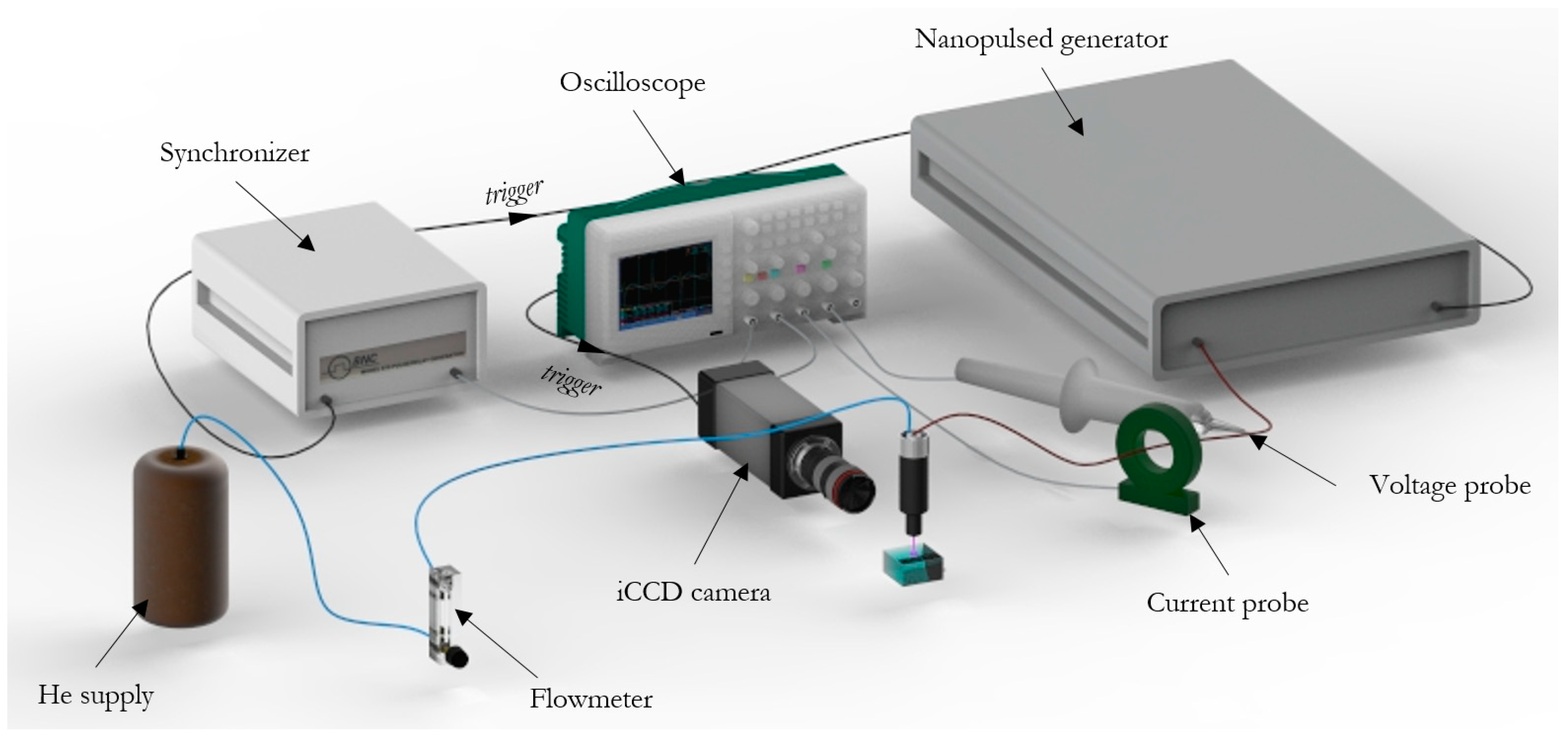
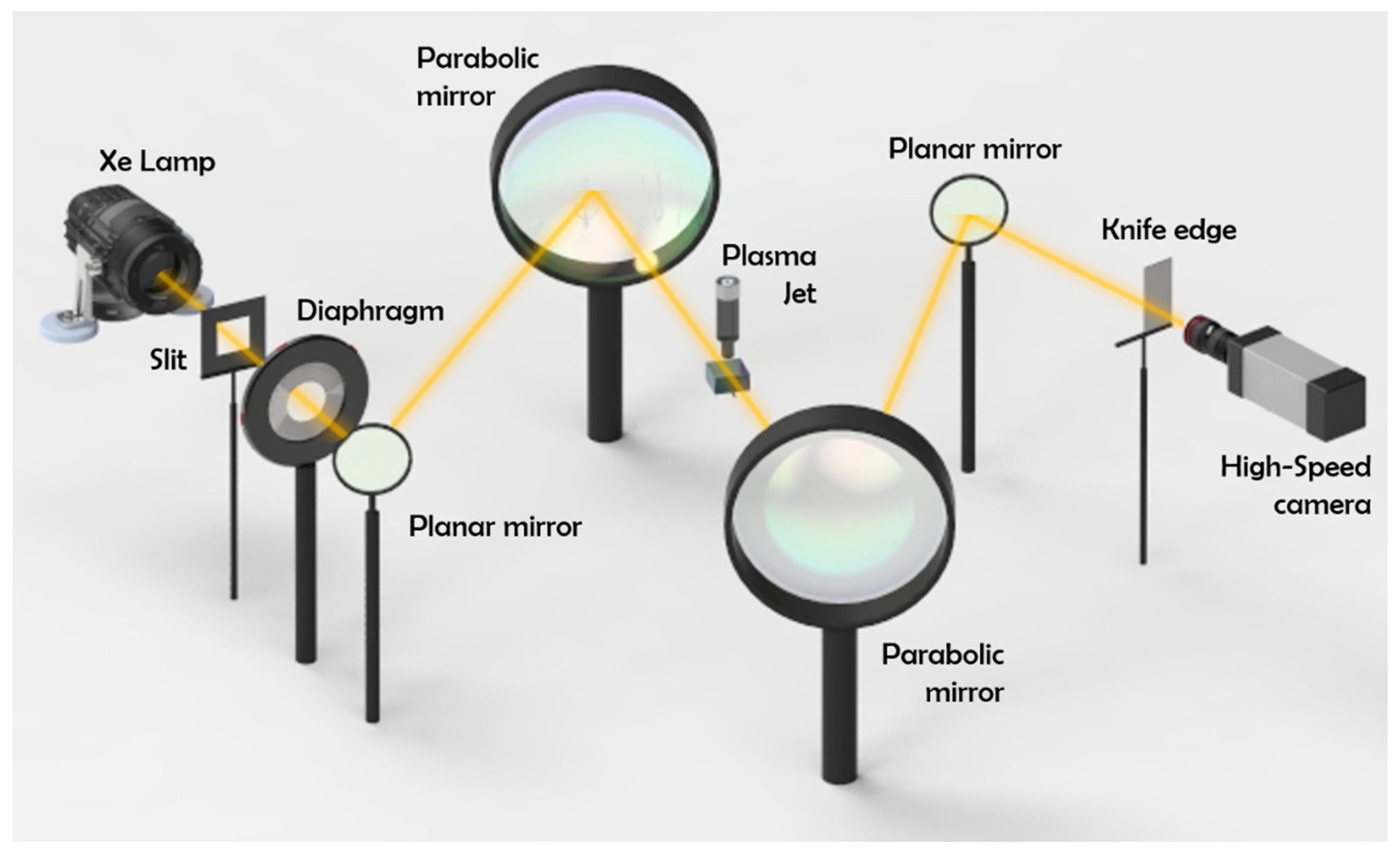
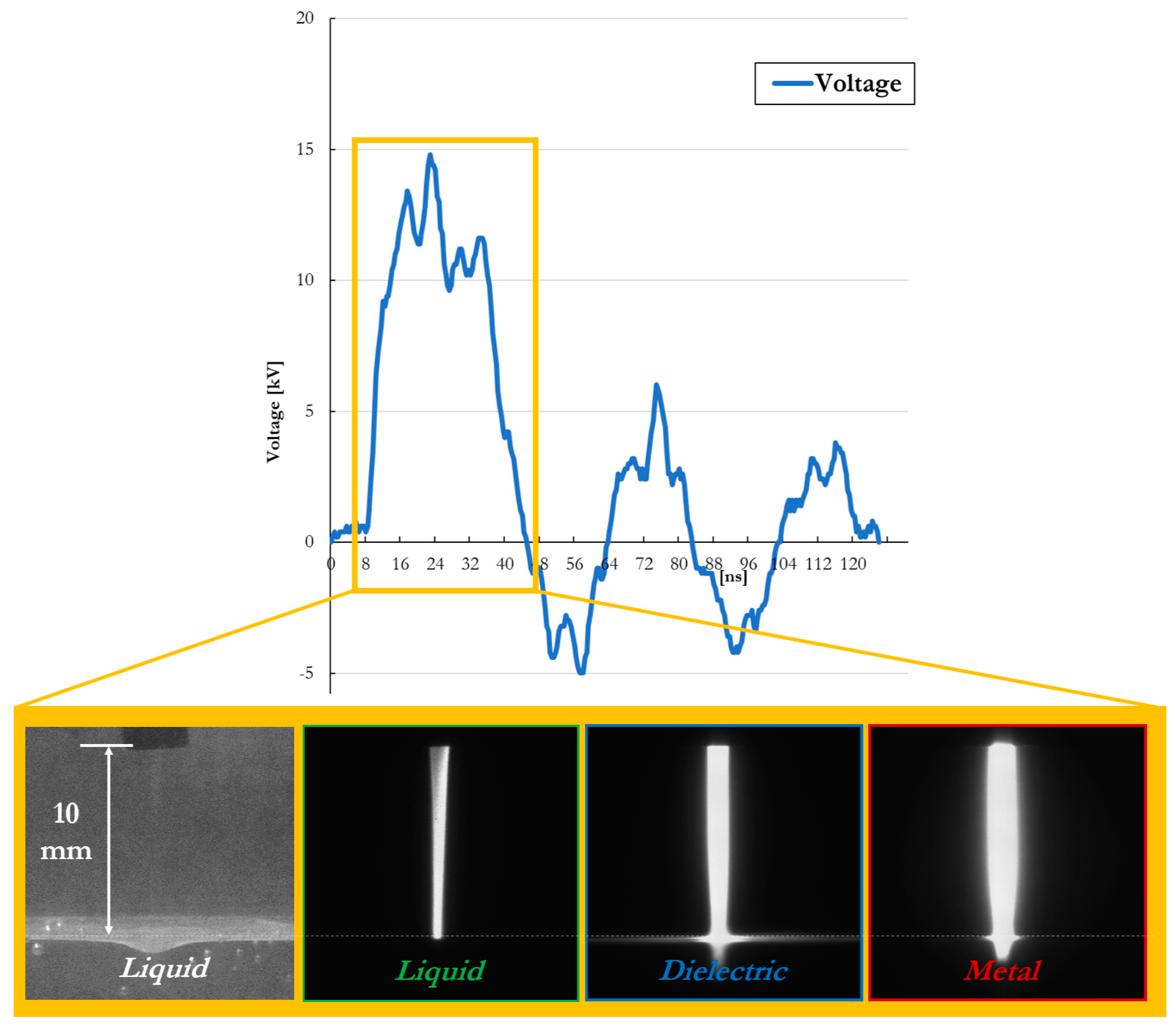
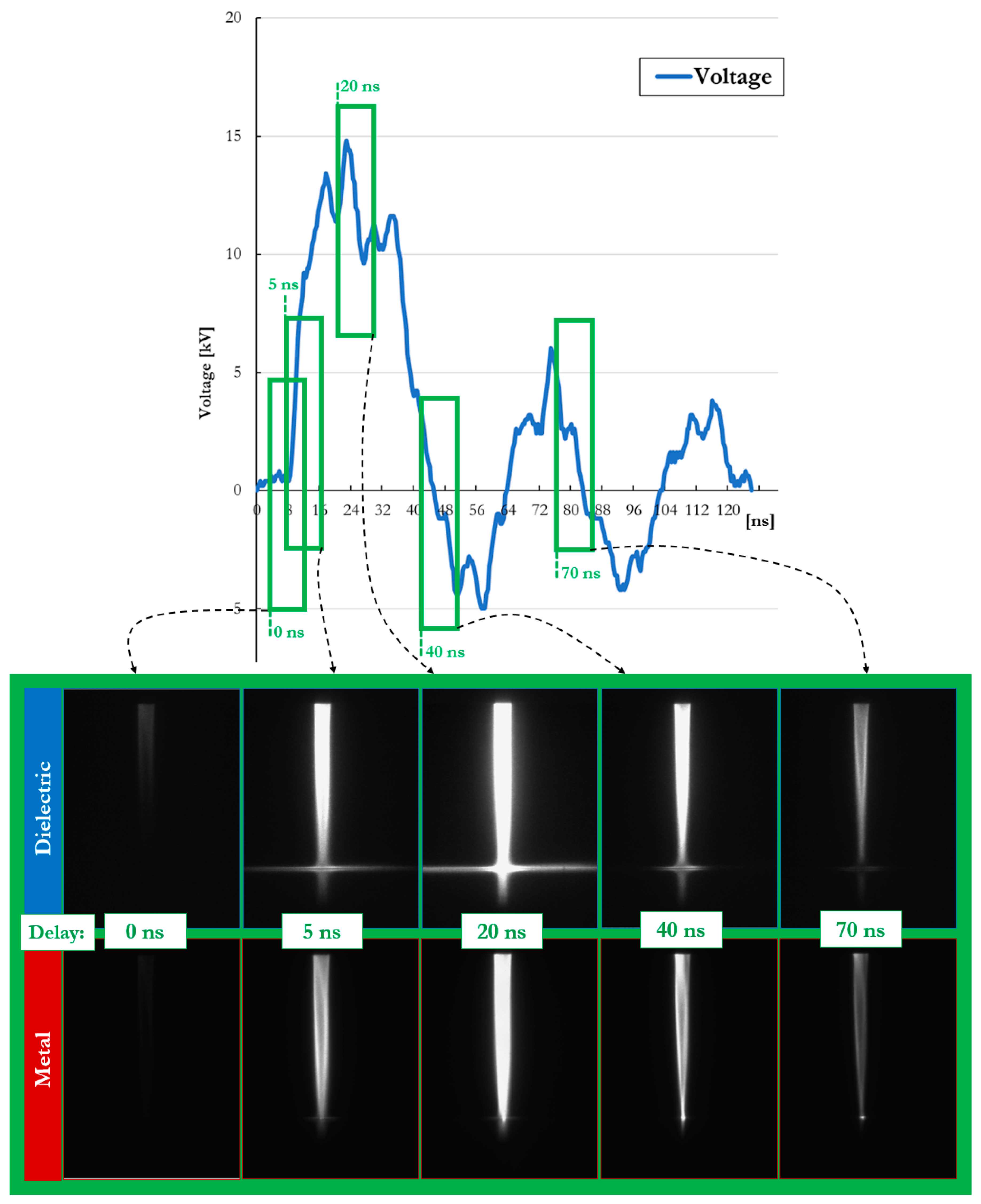
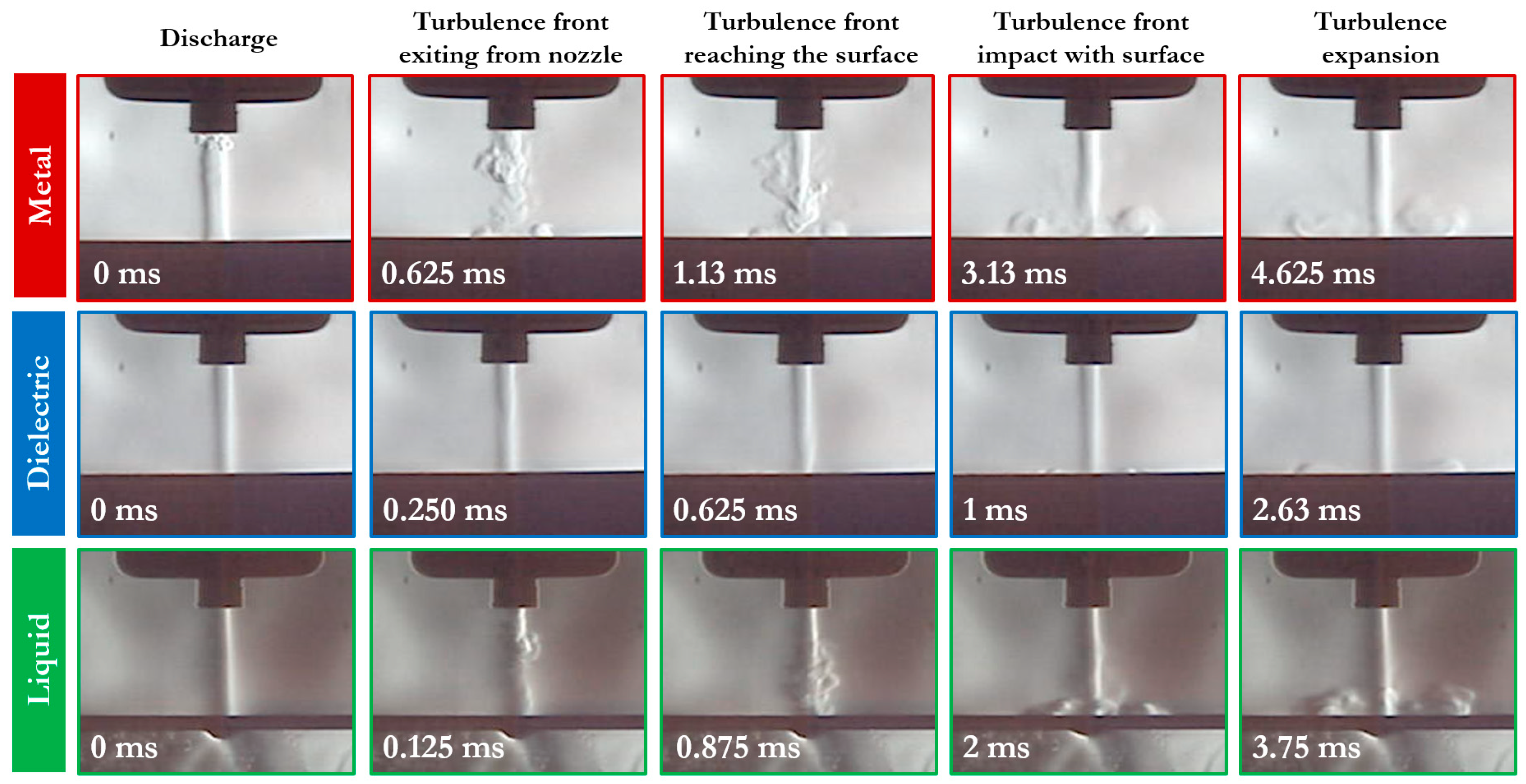
| Metal | Dielectric | Liquid (119 µS/cm) | |
|---|---|---|---|
| Power [W] | 0.434 | 0.313 | 0.255 |
© 2019 by the authors. Licensee MDPI, Basel, Switzerland. This article is an open access article distributed under the terms and conditions of the Creative Commons Attribution (CC BY) license (http://creativecommons.org/licenses/by/4.0/).
Share and Cite
Simoncelli, E.; Stancampiano, A.; Boselli, M.; Gherardi, M.; Colombo, V. Experimental Investigation on the Influence of Target Physical Properties on an Impinging Plasma Jet. Plasma 2019, 2, 369-379. https://doi.org/10.3390/plasma2030029
Simoncelli E, Stancampiano A, Boselli M, Gherardi M, Colombo V. Experimental Investigation on the Influence of Target Physical Properties on an Impinging Plasma Jet. Plasma. 2019; 2(3):369-379. https://doi.org/10.3390/plasma2030029
Chicago/Turabian StyleSimoncelli, Emanuele, Augusto Stancampiano, Marco Boselli, Matteo Gherardi, and Vittorio Colombo. 2019. "Experimental Investigation on the Influence of Target Physical Properties on an Impinging Plasma Jet" Plasma 2, no. 3: 369-379. https://doi.org/10.3390/plasma2030029
APA StyleSimoncelli, E., Stancampiano, A., Boselli, M., Gherardi, M., & Colombo, V. (2019). Experimental Investigation on the Influence of Target Physical Properties on an Impinging Plasma Jet. Plasma, 2(3), 369-379. https://doi.org/10.3390/plasma2030029








